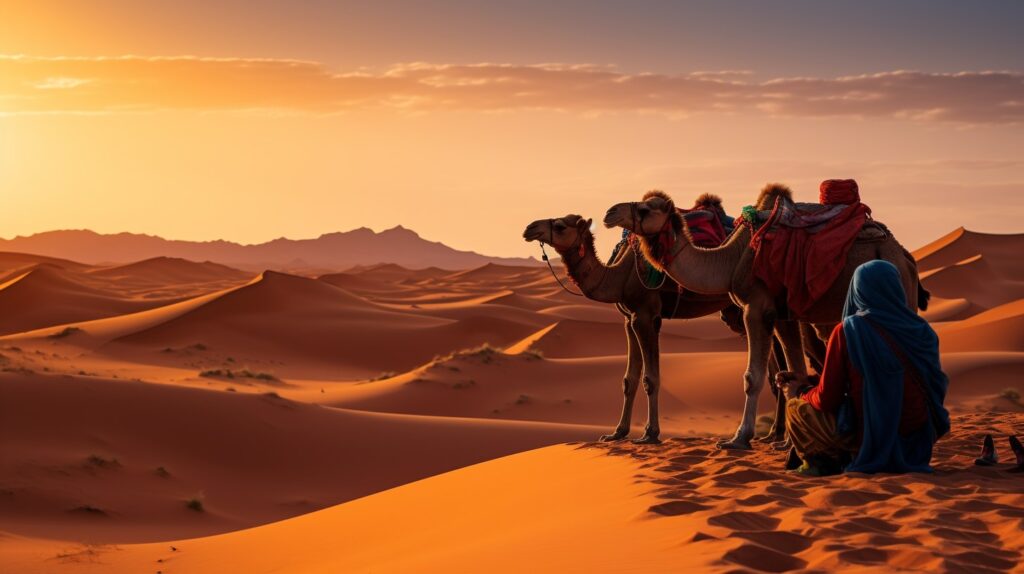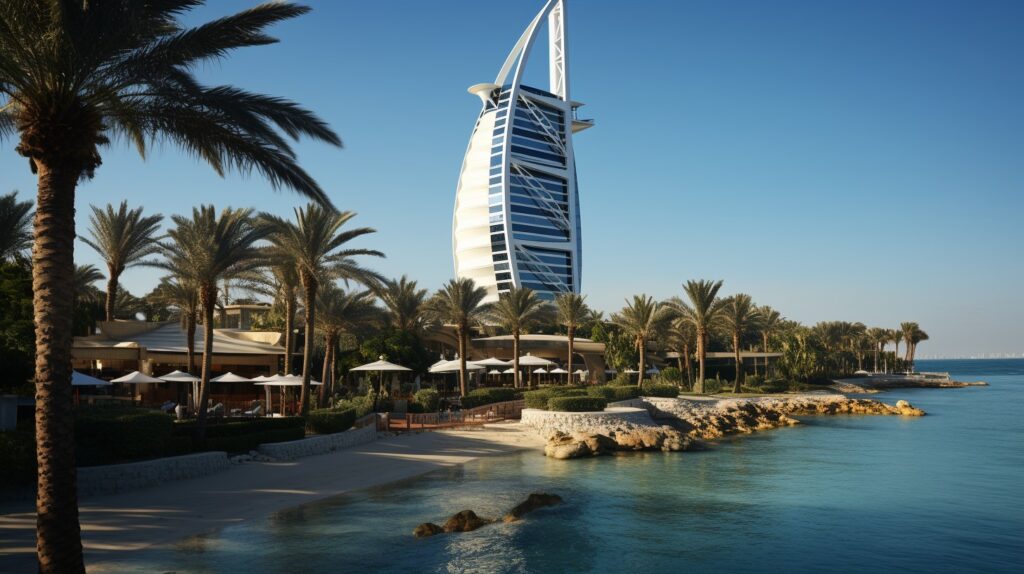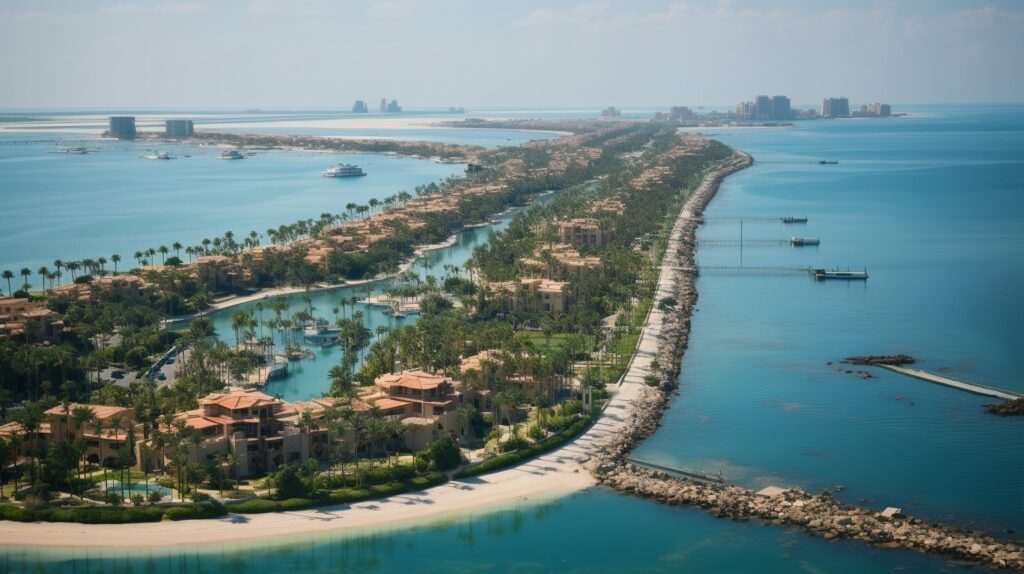Introduction
Dubai, a city that has risen from the sands to become a symbol of architectural grandeur and urban sophistication, tells a story as multifaceted as its skyline. Each building, each street, and each corner of this vibrant city narrates a chapter of an extraordinary journey from a humble fishing village to a bustling global metropolis. This article explores Dubai’s urban landscape, unraveling the layers of history, culture, and vision that have shaped its development. It’s a tale of transformation, ambition, and the relentless pursuit of excellence mirrored in the city’s ever-evolving skyline.
The Bedouin Roots: Echoes in the Sand
Before the towering skyscrapers and luxurious villas, Dubai’s story began with the Bedouin tribes, whose lifestyle and culture laid the foundation for the city’s early development.
Historical Context of Dubai’s Early Settlement: The origins of Dubai can be traced back to the Bedouin tribes, who roamed the desert and settled along the creek. Their simple yet resilient lifestyle influenced the early urban development of the area, with an emphasis on community living and adaptation to the harsh desert environment.
Bedouin Influence on the City’s Early Urban Development: The traditional Bedouin structures, made from palm fronds and locally available materials, were the first forms of housing in Dubai. These structures were designed to provide shelter from the scorching sun and were strategically located near water sources. The Bedouin’s nomadic culture and connection with the land are deeply ingrained in Dubai’s cultural heritage, reflected in the city’s early architectural choices.

Pearl Diving Era: The First Chapters of Trade
The pearl diving industry shaped Dubai’s early economy and urban landscape.
The Impact of the Pearl Diving Industry on Dubai’s Growth: Pearl diving was one of Dubai’s main economic activities before the discovery of oil. The industry brought wealth and trade opportunities, attracting merchants and settlers to the region. This era marked the beginning of Dubai’s transformation into a trading hub.
Architectural Remnants of the Pearl Diving Era: The architecture of this period was influenced by the needs of the pearl diving industry. Buildings were constructed along the creek to facilitate trade and transportation. The Al Shindagha area, near the mouth of the creek, is home to some of the oldest buildings in Dubai, offering a glimpse into the city’s pearl diving past.
Oil Discovery: A Turning Point in the Narrative
The discovery of oil in the 1960s was a watershed moment in Dubai’s history, dramatically altering its urban and economic landscape.
How Oil Discovery Reshaped Dubai’s Urban Landscape: The oil boom brought unprecedented wealth and population growth. This period began large-scale urban development by constructing modern infrastructure, roads, and buildings. The city started to expand beyond its traditional boundaries, paving the way for the modern metropolis we see today.
The Transition from a Traditional to a Modern Economy and Its Architectural Reflections: As Dubai transitioned from a traditional economy based on fishing and pearl diving to a modern, oil-based economy, its architecture evolved. The city started to embrace contemporary architectural styles, reflecting its new economic status and global aspirations. This era saw the construction of Dubai’s first skyscrapers, symbolizing the city’s upward trajectory.
The Rise of Modern Dubai: A Story of Ambition
As the 20th century progressed, Dubai embarked on a transformation journey, driven by ambition and a vision to create a city that would stand as a beacon of modernity and luxury.
Critical Developments in Modern Dubai’s Urban Expansion: The late 20th and early 21st centuries marked a period of rapid expansion and development in Dubai. The city’s leaders envisioned a world-class metropolis, creating ambitious projects such as the Palm Islands, the World Islands, and the Dubai Marina. These developments were not just about creating residential and commercial spaces; they were about making a statement on the global stage – that Dubai was a city of the future.
Architectural Symbols of Dubai’s Economic and Cultural Ambitions: Each project told a story of Dubai’s economic and cultural ambitions. The Palm Islands, for example, showcased Dubai’s ability to conquer natural challenges by creating artificial islands visible from space. The Burj Khalifa, the world’s tallest building, symbolizes the city’s desire to reach heights of architectural innovation and excellence.

Iconic Landmarks: Narratives Cast in Steel and Glass
Dubai’s skyline is dotted with buildings that are not just architectural marvels but also narrators of the city’s aspirations and achievements.
Stories Behind Dubai’s Most Iconic Buildings: The Burj Khalifa is more than just a skyscraper; it symbolizes Dubai’s unyielding ambition. Inspired by the desert flower Hymenocallis, its design is a nod to the city’s roots in the desert landscape. The Burj Al Arab, shaped like a sail, tells a story of Dubai’s maritime heritage, while its luxurious interiors speak of the city’s modern luxury.
How These Landmarks Contribute to Dubai’s Global Narrative: These iconic structures have played a crucial role in shaping Dubai’s narrative as a global city. They have become architectural landmarks, representing Dubai’s journey from a small trading port to a worldwide hub of tourism, business, and innovation.
Cultural Tapestry: Weaving Diversity into Urban Fabric
Dubai’s urban landscape is also a tapestry of diverse cultures, each adding thread to its rich cultural fabric.
The Influence of Diverse Cultures on Dubai’s Urban Landscape: As a melting pot of nationalities, Dubai’s architecture reflects a blend of influences from around the world. Areas like International City and the various themed villas in Jumeirah showcase architectural styles from different cultures. At the same time, traditional souks and modern shopping malls coexist, offering a glimpse into the city’s multicultural makeup.
Neighborhoods That Reflect Cultural Diversity: Neighborhoods such as Al Fahidi Historical Neighbourhood, with its traditional wind towers and narrow lanes, contrast sharply with the modern, cosmopolitan feel of areas like Downtown Dubai. These neighborhoods tell stories of Dubai’s past and present, roots, and global connections.
Sustainability and Future Visions: The Next Chapter
As Dubai looks to the future, sustainability and intelligent city planning have become key themes in its urban narrative.

Dubai’s Initiatives in Sustainable Development and Smart City Planning: In recent years, Dubai has focused on sustainable development, recognizing the need to balance rapid growth with environmental responsibility. Projects like Sustainable City, focusing on renewable energy and eco-friendly living, are examples of how Dubai integrates sustainability into its urban planning.
Predictions for the Future Narrative of Dubai’s Urban Landscape: Looking ahead, Dubai’s urban landscape is set to evolve further, focusing on sustainability, technological innovation, and smart city solutions. The city’s commitment to creating a livable, efficient, and future-ready environment will shape its narrative in the coming years, adding new chapters to its already remarkable story.
